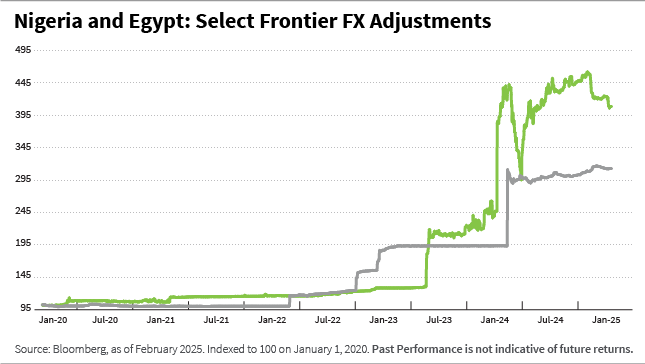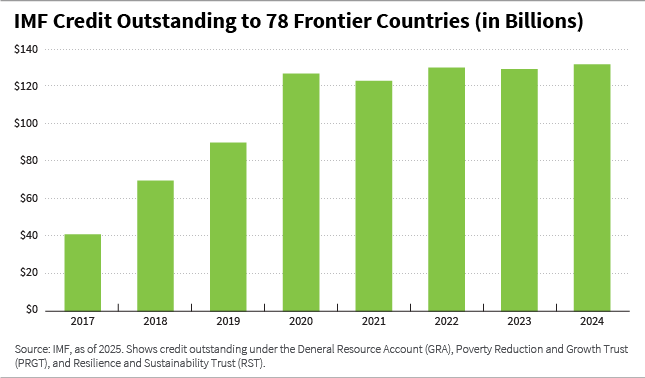March 3, 2025 | Emerging Markets Debt
6 Reasons to Consider Frontier Markets Debt

Opportunities have increased significantly in frontier markets debt as more countries have made a conscious effort to open their capital markets to international investors and currencies have become more fairly valued. As a result, we believe the time may be right for an allocation to frontier markets debt through a dedicated strategy. Here are six reasons why.
1—Investment Opportunities Have Increased
Investment opportunities in frontier markets debt have increased in recent years as a result of structural improvements, valuation shifts, greater diversification potential, and continued growth in hard currency frontier debt.
- Structural improvements: More frontier economies are opening their local capital markets to international investors, driven by pro-market reforms supported by multilateral development partners, reduced capital controls, and enhanced liquidity measures provided by central banks.
- Attractive valuations: Many frontier currencies have undergone significant devaluations, leading to what we view to be more fairly valued currencies alongside attractive interest rates. This environment allows investors to access higher-yielding assets while potentially benefiting from improved currency valuations.
- Greater diversification potential: Previously, emerging market managers typically allocated to frontier local markets in a concentrated manner. However, we believe the asset class has now evolved sufficiently to stand as a diversified investment category.
- Growing access to hard currency frontier debt: This segment of the asset class has seen a growing and diversified issuer base for more than a decade. Hard currency frontier bonds continue to offer relatively high nominal yields with valuations pointing to room for further spread compression. We also believe that restructuring risk is likely to be low over at least the near future, following successful negotiations with bondholders in recent default cases. We believe the resilience of recovery values for Eurobond investors further strengthens the case for investment.
2—Valuations Have Improved
In frontier countries, central banks often use the nominal exchange rate as a financial and economic policy anchor while managing borrowing costs. However, investing in bonds of countries with overvalued currencies and low carry can be risky.
Over the past four years, harsh global macroeconomic conditions and policy measures supported by the International Monetary Fund (IMF) have pushed many frontier markets to abandon unsustainable currency pegs and managed exchange rates, leading to more competitively valued currencies (see the chart below for the meaningful adjustment in Nigeria and Egypt).
Concurrently, we believe monetary policy tightening and sharp interest-rate hikes have strengthened the investment case for frontier markets debt.

3—Inefficiency Can Be Exploited
In frontier markets, we believe a persistent lack of transparency and research coverage embeds an unwarranted risk premium in certain frontier assets. This inefficiency presents opportunities for skilled managers to capitalize on:
- High yield per unit of duration: Hard currency frontier bonds often provide an outsized yield relative to their risk profile.
- High risk-adjusted carry: Local frontier markets frequently exhibit currency forwards with risk-adjusted returns that exceed those of developed or emerging markets.
- Underrepresentation in global benchmarks: The relatively low international ownership of frontier assets may further enhance these opportunities.
This phenomenon is even more pronounced in frontier markets than in non-frontier emerging markets, as international ownership is minimal and access to information more difficult.
4—Correlations to Traditional Asset Classes Are Generally Low
Frontier market debt has historically exhibited low correlation to traditional asset classes, making it a potentially valuable diversifier. Several key factors contribute to this:
- Absence of dedicated exchange-traded funds (ETFs): ETFs currently have no exposure to frontier local markets. Without ETF-driven liquidity swings, frontier markets are typically less prone to volatility driven by large passive flows.
- Low international participation: Market access challenges and a lack of a globally recognized benchmark limit participation and in turn may reduce susceptibility to global risk sentiment shifts.
- Returns tend to be driven by predominantly bottom-up factors: Market returns tend to be primarily driven by country-specific dynamics rather than broad macroeconomic trends.
In addition to not being highly correlated with other risk assets, frontier markets are generally not highly correlated with one another. Even within the same country, hard and local currency bonds often display low correlation, which can further enhance portfolio diversification.
5—Sponsorship Has Improved Fundamentals
Many frontier economies enjoy strong geopolitical importance and recognition of economic opportunities, attracting significant support from multilateral and bilateral institutions. A large proportion of these markets currently benefit from IMF programs and further support from development partners, which provide:
- Low-cost financing: Reducing fiscal strain and enhancing economic stability.
- Economic reforms: Encouraging market-friendly policies, including subsidy removals and privatization efforts.
- Improved debt sustainability: Strengthening economic fundamentals, lowering default risks, and increasing growth potential.
Such reforms are helping improve structural growth potential across many frontier markets, putting debt levels on a more sustainable path, and may reduce the probabilities of large drawdowns in asset prices.

6—Risk-Adjusted Return Potential Is Compelling
We believe the combination of excess risk premium, diversification benefits, low correlation with traditional assets, and strong institutional sponsorship makes frontier markets debt an attractive asset class. Historically, it has offered high Sharpe ratios as a result of:
- Overcompensation for volatility: High carry and risk-adjusted premiums offset perceived risks.
- Resilient recovery rates: Even in default scenarios, frontier markets debt has historically delivered relatively strong recovery values.
- Active management advantage: Experienced managers can unlock additional alpha through strategic asset allocation and rigorous risk mitigation.
We believe a high Sharpe ratio has the potential to persist given that the high carry and risk-adjusted premia overcompensate investors for volatility, default risk, and loss potential.
The Importance of Active Management
We believe frontier markets debt is an underappreciated asset class that offers compelling risk-adjusted return potential and meaningful diversification benefits. With inefficiencies that can be exploited through active management, improving fundamentals, and robust institutional sponsorship, we believe it presents an exciting investment opportunity for today’s investors. By employing a disciplined, research-intensive, and diversified approach, we believe investors can enhance returns while effectively managing risks in this dynamic market segment.
Read our paper to learn how we seek to capture risk-adjusted return potential with our emerging markets frontier debt strategy.
Yvette Babb is a portfolio manager on William Blair’s emerging markets debt team.
Daniel Wood is a portfolio manager on William Blair’s emerging markets debt team.


